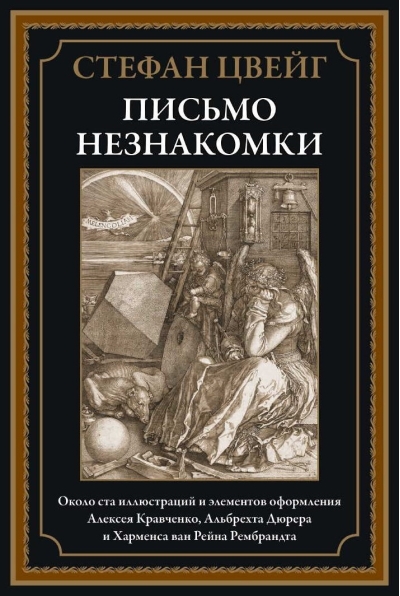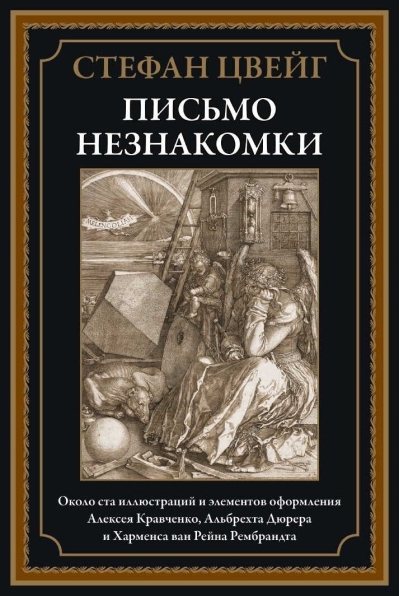Letter from a stranger
14.99 €
The only thing available 1
The collection includes landmark novels by Stefan Zweig: "Amok", "Letter from a Stranger" translated by D. M. Gorfinkel, "Twenty-Four Hours in the Life of a Woman" translated by L. I. Wolfson, as well as eight short stories of this famous Austrian writer of the first third of XX century, who gained fame as a master of psychological portraiture. The works of the collection are illustrated with magnificent graphic works by the talented artist Alexei Ilyich Kravchenko.
Stefan Zweig gained worldwide fame as a talented novelist. Written in this genre, his most iconic works make up this collection. Zweig also composed fascinating romanticized hagiographies, reconstructing on the basis of various documents the motives of human actions and subtly describing the psychological background of the actions of his characters. And they often became close friends of the writer, such as Romain Rolland, Sigmund Freud and many other creative personalities of the first third of XX century. The childhood of the future writer passed cloudless. Stefan was the son of a factory worker, he studied at the gymnasium, and then studied philosophy at the University of Vienna. The First World War changed everything. A convinced pacifist Zweig believed that it will be the last meat grinder in Europe, and writers like him can prevent a new catastrophe. Alas! In 1934, Stefan Zweig left his beloved Austria in time for England. When the Second World War broke out on its territory, he fled to the United States, and then to Brazil. There, in the suburbs of Rio de Janeiro, Zweig and his wife committed suicide in late February 1942, taking a lethal dose of sleeping pills. The world that the writer loved so much and that he described in his novels was gone forever. Zweig could not bear it. Novella "Invisible Collection" in the book is decorated with engravings by Durer and Rembrandt. and the rest of the collection - illustrations by the talented artist AI Kravchenko. He is known to book lovers as a fine master who enriched the editions of Hoffmann, Hugo, Gogol and Pushkin with his graphics. Alexey Ilyich was an excellent master of the technique of linocut and etching; he masterfully conveyed with the help of strokes and the actions of formidable forces of nature, and the movements of the human soul. At the same time, he was an outstanding painter and a fine colorist. At the International Exhibition of Decorative Arts held in Paris in 1925, Kravchenko's works received the highest award. The future artist was born in Samara province of pre-revolutionary Russia. His first drawing teacher was a visiting icon painter. The craving for education led the young man to Moscow. At the School of Painting, Sculpture and Architecture his mentors were Korovin, Serov and Vasnetsov. Before the revolution, Alexei Ilyich studied painting in Italy and Greece, his works found their way to the Hermitage and the Tretyakov Gallery. In 1925. Kravchenko worked in Venice, Florence, Pisa and Rome. In 1929 he represented the art of Soviet Russia in New York at the International Art Exhibition, and in 1935 he became a professor at the Moscow Institute of Fine Arts. Alexei Ilyich practiced what he loved literally until his last breath - he died in his studio in 1940.
Stefan Zweig gained worldwide fame as a talented novelist. Written in this genre, his most iconic works make up this collection. Zweig also composed fascinating romanticized hagiographies, reconstructing on the basis of various documents the motives of human actions and subtly describing the psychological background of the actions of his characters. And they often became close friends of the writer, such as Romain Rolland, Sigmund Freud and many other creative personalities of the first third of XX century. The childhood of the future writer passed cloudless. Stefan was the son of a factory worker, he studied at the gymnasium, and then studied philosophy at the University of Vienna. The First World War changed everything. A convinced pacifist Zweig believed that it will be the last meat grinder in Europe, and writers like him can prevent a new catastrophe. Alas! In 1934, Stefan Zweig left his beloved Austria in time for England. When the Second World War broke out on its territory, he fled to the United States, and then to Brazil. There, in the suburbs of Rio de Janeiro, Zweig and his wife committed suicide in late February 1942, taking a lethal dose of sleeping pills. The world that the writer loved so much and that he described in his novels was gone forever. Zweig could not bear it. Novella "Invisible Collection" in the book is decorated with engravings by Durer and Rembrandt. and the rest of the collection - illustrations by the talented artist AI Kravchenko. He is known to book lovers as a fine master who enriched the editions of Hoffmann, Hugo, Gogol and Pushkin with his graphics. Alexey Ilyich was an excellent master of the technique of linocut and etching; he masterfully conveyed with the help of strokes and the actions of formidable forces of nature, and the movements of the human soul. At the same time, he was an outstanding painter and a fine colorist. At the International Exhibition of Decorative Arts held in Paris in 1925, Kravchenko's works received the highest award. The future artist was born in Samara province of pre-revolutionary Russia. His first drawing teacher was a visiting icon painter. The craving for education led the young man to Moscow. At the School of Painting, Sculpture and Architecture his mentors were Korovin, Serov and Vasnetsov. Before the revolution, Alexei Ilyich studied painting in Italy and Greece, his works found their way to the Hermitage and the Tretyakov Gallery. In 1925. Kravchenko worked in Venice, Florence, Pisa and Rome. In 1929 he represented the art of Soviet Russia in New York at the International Art Exhibition, and in 1935 he became a professor at the Moscow Institute of Fine Arts. Alexei Ilyich practiced what he loved literally until his last breath - he died in his studio in 1940.
See also:
- All books by the publisher
- All books by the author
- All books in the series Library of World Literature



































